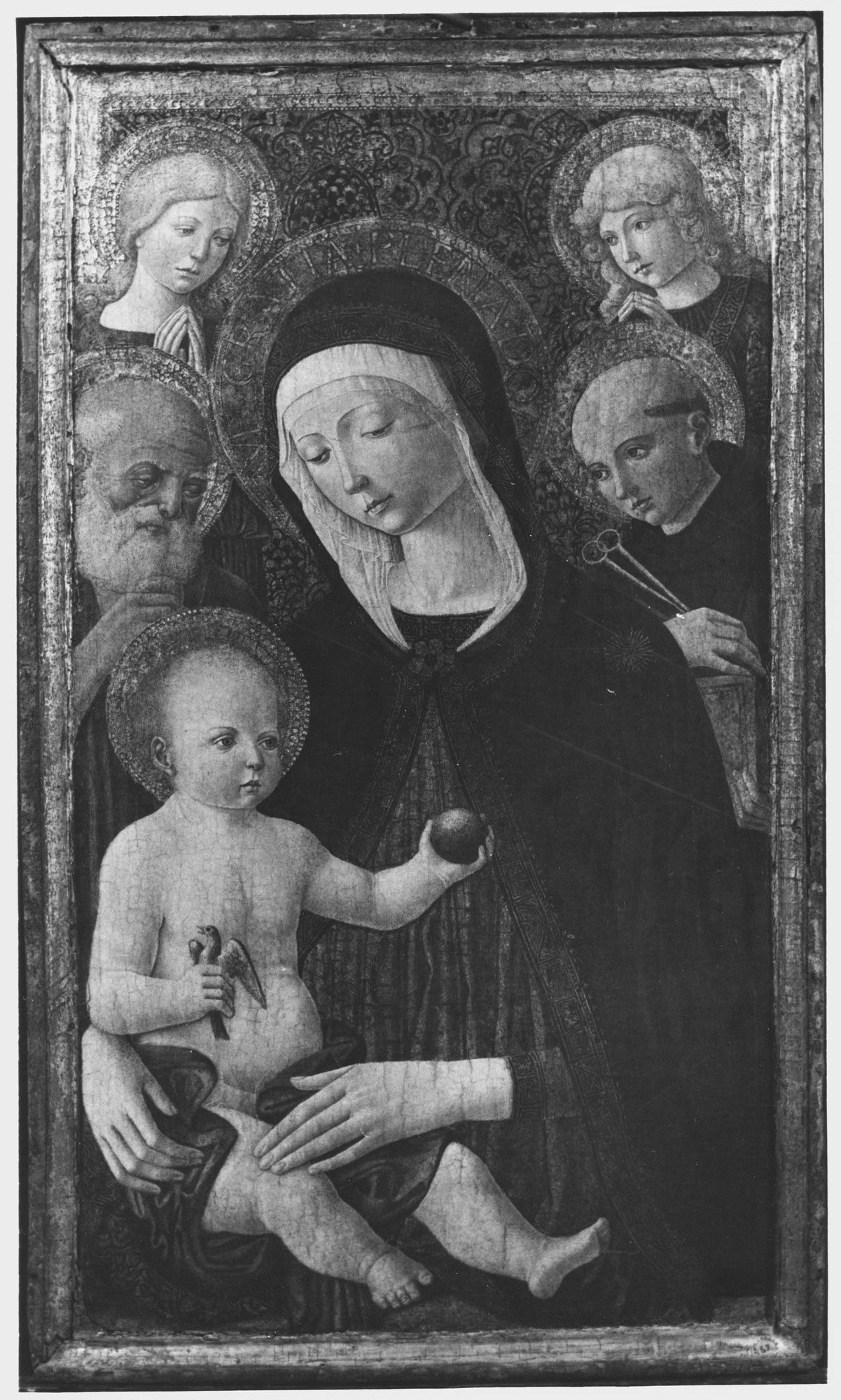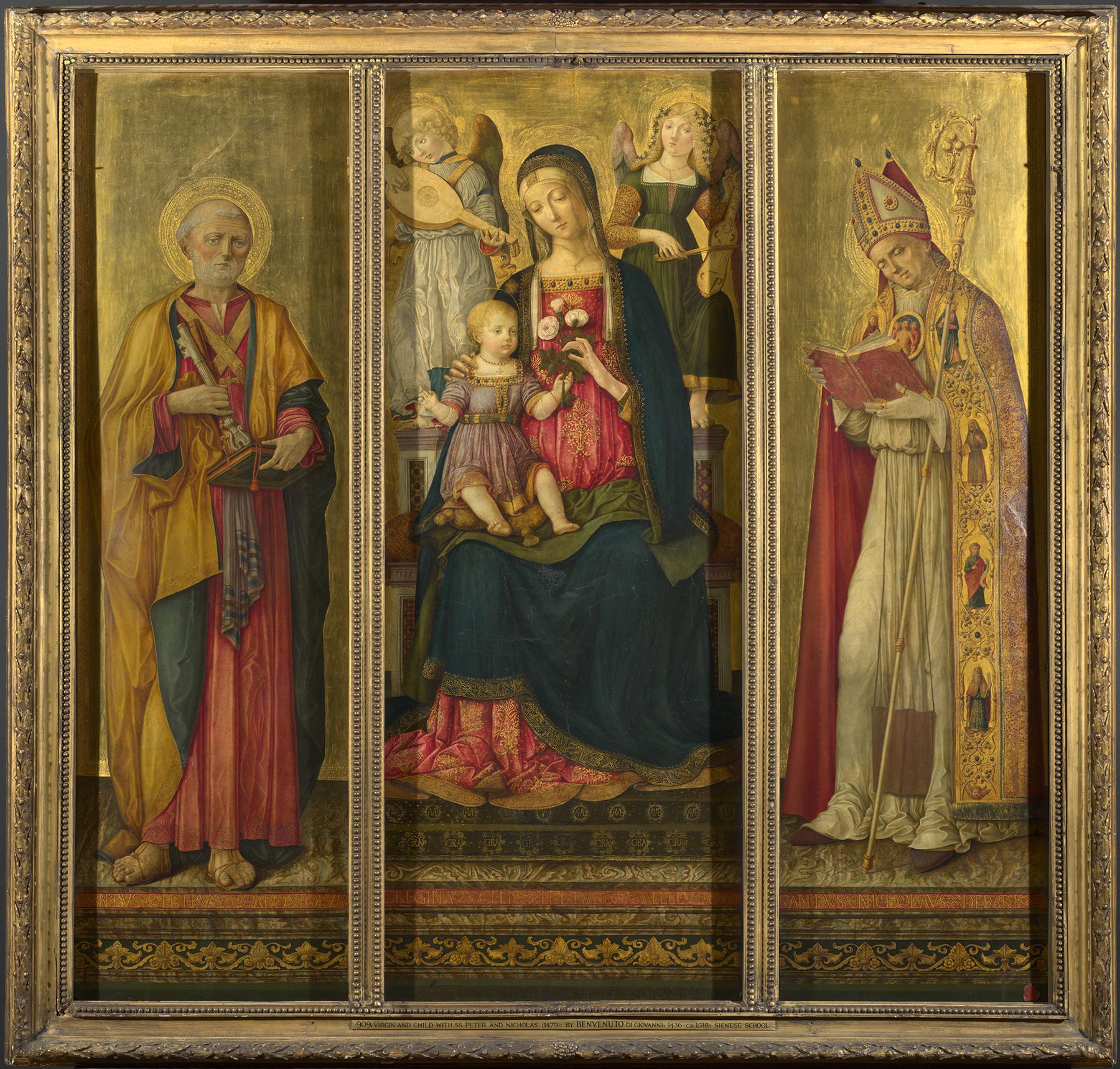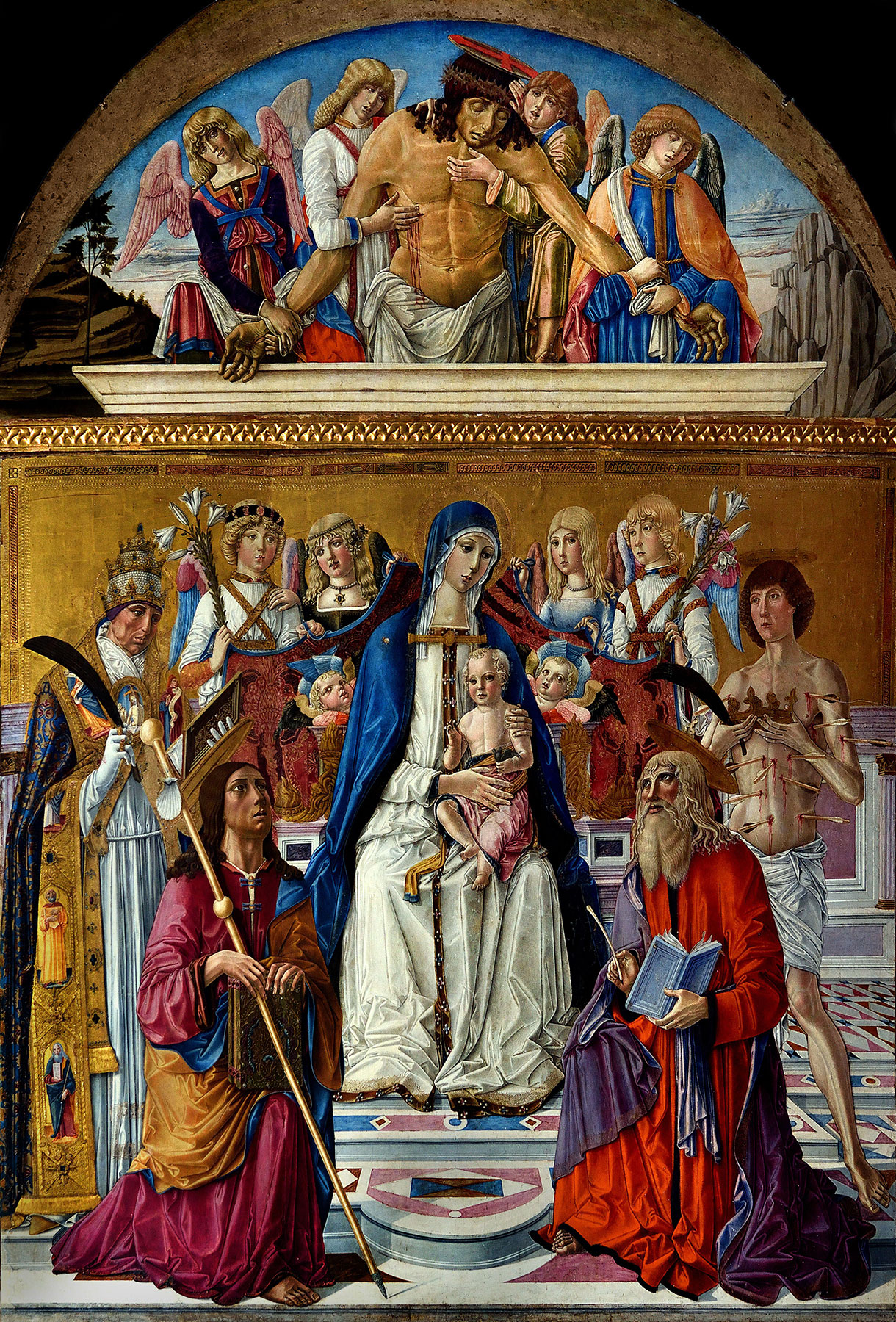Maccari, Borghetto, Siena; Giuseppe Mazzoni, Siena, ca. 1923; Maitland Fuller Griggs (1872–1943), New York, by 1925
The panel support, a single plank with a vertical wood grain, retains its original thickness of 4 centimeters. The lateral edges at the back are both beveled, possibly to accommodate irregularities of the tree trunk from which it was cut. The back is gessoed and painted as fictive marble. Two holes drilled into the top edge and top center of the back held a hanging strap. Engaged frame moldings, 1 centimeter thick, are preserved around three sides of the panel but are missing at the bottom, which is much consumed by wood worm and water(?) damage. The once-elaborate gilding on the panel is abraded and disfigured by large areas of complete loss to the right of center at the top of the composition, at the left side of the Virgin’s halo, and through the front of her richly tooled dress. The paint surface was extensively “burned” by caustic solvents, above all in the Virgin’s blue mantle and along the edges of raised craquelure in the Christ Child’s body, the Virgin’s face, and the face of the angel at the upper right. A large knot in the panel beneath the Virgin’s forehead has provoked further damage in that area. Although the visual integrity of the image is entirely compromised by the network of losses and exposed gesso and wood, the paint that does survive is rich in color and texture, currently muted by a flat synthetic varnish that lends a parched look to the surface.
Writing in his diary, entitled Giornale dell’antiquario, on August 23, 1955, the Sienese dealer Giuseppe Mazzoni described how, just over thirty years earlier, his father, Foresto Mazzoni, advised him to visit a farmer named Maccari, who wished to sell all the old furnishings in his home outside the Porta Tufi. The only object of interest Mazzoni found was a grimy panel with an image of the Virgin hanging above a sink in a lavatory, covered in dust and fly specks. Having purchased the picture for seven hundred lire, he brought it to Icilio Federico Joni—well known as a restorer and a forger of early Italian panel paintings—who confirmed Mazzoni’s intuition that it was the work of Benvenuto di Giovanni: “He took a liquid and, with extreme delicacy, removed the grease, caressing the painting with a moistened hand, pausing over the nudity of the Child and the brightness of the angels. . . . A month and a half later Maccari’s panel was reborn as an angelic thing.”1 In the event, Joni’s intervention (fig. 1) was far more extensive than a simple delicate cleaning of the surface. The painting had been severely compromised by caustic soda damage, subsequently exacerbated by its harsh cleaning at Yale in 1953, but Joni successfully integrated the surprisingly rich surface that did remain, demonstrating a remarkable sensitivity to the nuances of Benvenuto di Giovanni’s style—aside from his gratuitous introduction of a fabric pattern to cover losses in the gold ground and his liberal invention in the heads of the angel at the upper right and of Saint Jerome at the lower left.

Completed with Joni’s restorations, the painting elicited no doubts in the early literature referring to it. Richard Offner, in a 1925 lecture at Maitland Fuller Griggs’s home, declared it a fine example of Benvenuto di Giovanni’s work.2 Piero Misciattelli, perhaps misled by the rounded proportions of all the figures, preferred to see it as a work by Girolamo di Benvenuto closely dependent on his father’s style, a prime example of the confusion that can arise in distinguishing between the two artists.3 Bernard Berenson, too, listed the painting as by Girolamo di Benvenuto working in his father’s shop,4 an opinion repeated by Raimond van Marle.5 Following its cleaning at Yale in 1953, the painting has regularly been recognized as by Benvenuto di Giovanni, although Charles Seymour, Jr., hesitantly referred it to the artist’s workshop, and Maria Cristina Bandera consigned it to a catalogue appendix, stating that while Benvenuto’s authorship is “probable,” dating the picture is problematic.6 Indeed, few opinions about dating have been ventured. Burton Fredericksen and Darrell Davisson and Serena Gunther suggested the period 1475–78—that is, about the time of Benvenuto’s Montepertuso altarpiece of 1475 and before his large triptych in the National Gallery, London (fig. 2), dated 1479.7 Seymour opted for a date in the following decade, and Carl Strehlke, presumably following the logic of Girolamo di Benvenuto’s known period of activity in his father’s workshop, suggested a date in the 1490s.8

Fredericksen and Davisson may have been correct in their assessment of the relationship of the Yale painting to the Montepertuso and London altarpieces, judging from the better-preserved passages in the face of the Virgin and the remaining traces of modeling in the other five figures. It is the London altarpiece (see fig. 2), removed in the eighteenth century from the church of the Gesù in Orvieto, that provides the closest parallel for the proportions and attitudes of the figures—and even the composition—in the Yale painting, allowing for the evident differences in scale and purpose between the works, suggesting a date for it in the late 1470s. A lack of agreement on this point probably stems in large part from the difficulty of understanding the condition of the Yale painting in available photographs of it and from a confusion inherent within traditional assessments of Benvenuto di Giovanni’s career. The Montepertuso altarpiece (1475) and the London triptych (1479) are firmly dated works, but they are commonly thought to be divided from each other by the execution of the Borghesi altarpiece (fig. 3) in San Domenico, Siena, believed to have been painted between 1476 and 1478. The Borghesi altarpiece not only bears no appreciable relationship to the Yale painting, but it has also given rise to conflicting opinions regarding the dating of other small scale works from the middle period of Benvenuto’s activity.

The Borgehesi altarpiece had routinely been associated by early writers with a documented notice of Benvenuto di Giovanni being paid for work in the Bellanti Chapel in San Domenico in 1483, and thus provided a fixed point for dating other works in that decade. It was noted, however, by Bandera that the four saints included in the altarpiece do not correspond to the dedication of the Bellanti Chapel to Saints John the Baptist and Anthony, and Max Seidel later argued that the altarpiece was instead painted for the Borghesi Chapel, dedicated to Saints Fabian and Sebastian.9 Seidel further observed that the Borghesi Chapel altarpiece must have been completed not in 1483 but by 1478 at the latest, when it is cited as a model in the contract for Matteo di Giovanni’s altarpiece in the nearby chapel of the German confraternity in Siena, dedicated to Saint Barbara.10 It has since become a convention to assume that the painting was completed shortly before 1478, although the Borghesi Chapel was founded in 1467, and it is at least logically possible that the altarpiece could have been commissioned anytime within the eleven year span between those dates. The prominence of the Borghesi family in Siena and the magnitude of their investment in this chapel could indeed suggest that it is not logical to assume that the commission might have been delayed as long as ten years.
One problem with assessing the probable date of the Borghesi altarpiece is the stylistically heterogeneous nature of the various fragments associated with it in scholarly reconstructions. Two sets of full-length and half-length saints (for the latter, see Benvenuto di Giovanni, Saint Peter Martyr) frequently identified as the pilasters and predella, respectively, of the missing altarpiece frame must be assignable to two different periods of Benvenuto’s career. They have in common nothing more than the occurrence of a selection of Dominican saints among their number. Even more misleading is the relationship of the main panel of the altarpiece to the lunette, representing the Dead Christ supported in His tomb by angels (see fig. 3), associated with it in San Domenico since the early nineteenth century. The lunette has clearly been cut down from a larger structure to match approximately the overall width of the main panel beneath it. It is also evidently a work of the 1480s, much closer in style to the 1491 Ascension altarpiece from Sant’Eugenio than is any other work by Benvenuto putatively of the 1470s. The question must be posed whether the lunette was originally part of another work, possibly of Benvenuto’s 1483 Bellanti altarpiece (the rest of which is not known to survive), and was amalgamated instead to the Borghesi altarpiece at a later date. Considering the two panels as stylistically coeval makes it impossible to date either or to relate independent works to the resultant hybrid structure. Separating them, by contrast, enables the main panel to be recognized as a midterm between Benvenuto’s altarpieces of the Nativity (in Volterra)11 and the Annunciation (in Sinalunga),12 both of 1470, and his Montepertuso altarpiece of 1475, not as a midterm between Montepertuso and London in the second half of that decade. It also enables a date for the Yale panel to be established between 1475 and 1479 without conflicting with any other dated or securely datable works of art.
The extremely compromised condition of the Yale panel has elicited no other discussion of it in the art-historical literature, except for Seymour’s mistaken identification of the saint at the right as Saint Peter,13 presuming that the objects held in his hands are the gold and silver keys always associated with Peter as attributes. The figure, however, is wearing black or dark gray, not Peter’s conventional colors of yellow and blue, and the object he holds in his right hand—his left hand supports a book with a red binding—is a pair of iron manacles, not the gold and silver keys. The manacles are an attribute of Saint Leonard, who was infrequently portrayed in fourteenth- and fifteenth-century Italian painting (see Master of the Yale Dossal, Virgin and Child Enthroned between Saints Leonard and Peter and Scenes from the Life of Saint Peter). The patron saint of prisoners, it is likely that his inclusion in this case is a reference to the original patron’s name or patronymic. —LK
Published References
Misciattelli, Piero. “Arte antica senese: Una tavola di Girolamo di Benvenuto e una terracotta di Neroccio.” La Diana 2, no. 2 (1927): 142–43. , 142–43; Berenson, Bernard. Italian Pictures of the Renaissance: A List of the Principal Artists and Their Works with an Index of Places. Oxford: Clarendon, 1932., 253; Berenson, Bernard. Pitture italiane del Rinascimento: Catalogo dei principali artisti e delle loro opere. Trans. Emilio Cecchi. Milan: Ulrico Hoepli, 1936., 217; van Marle, Raimond. The Development of the Italian Schools of Painting. Vol. 16. The Hague: M. Nijhoff, 1937., 421–22; Fredericksen, Burton B., and Darrell D. Davisson. Benvenuto di Giovanni, Girolamo di Benvenuto: A Summary Catalogue of Their Paintings in America. Los Angeles: J. Paul Getty Museum, 1966., 27, 35, fig. 13; Berenson, Bernard. Italian Pictures of the Renaissance, A List of the Principal Artists and Their Works with an Index of Places: Central Italian and North Italian Schools. 3 vols. London: Phaidon, 1968., 1:187; Seymour, Charles, Jr. Early Italian Paintings in the Yale University Art Gallery. New Haven: Yale University Art Gallery, 1970., 188–89, 318, no. 141; Fredericksen, Burton B., and Federico Zeri. Census of Pre-Nineteenth-Century Italian Paintings in North American Public Collections. Cambridge, Mass.: Harvard University Press, 1972., 600; Gunther, Serena. “Benvenuto di Giovanni di Meo del Guasta.” In Allgemeines Künsterlexikon. Munich: K.G. Saur, 1994). , 192; Bandera, Maria Cristina. “I falsi di Benvenuto di Giovanni, tra Otto e Novecento: Un capitolo importante del collezionismo dei primitivi.” Paragone, 3rd ser., 49, no. 20 (581) (July 1998): 26–46. , 30; Bandera, Maria Cristina. Benvenuto di Giovanni. Milan: Federico Motta, 1999., 123, 126, 250–51, no. 18; Mazzoni, Gianni. Quadri antichi del novecento. Vicenza: Neri Pozza, 2001., 56, 120–28, 410–11
Notes
-
The full text is quoted in Mazzoni, Gianni. Quadri antichi del novecento. Vicenza: Neri Pozza, 2001., 124. ↩︎
-
Lecture notes recorded in the Frick Art Reference Library, New York. ↩︎
-
Misciattelli, Piero. “Arte antica senese: Una tavola di Girolamo di Benvenuto e una terracotta di Neroccio.” La Diana 2, no. 2 (1927): 142–43. , 142–43. ↩︎
-
Berenson, Bernard. Italian Pictures of the Renaissance: A List of the Principal Artists and Their Works with an Index of Places. Oxford: Clarendon, 1932., 253; Berenson, Bernard. Pitture italiane del Rinascimento: Catalogo dei principali artisti e delle loro opere. Trans. Emilio Cecchi. Milan: Ulrico Hoepli, 1936., 217; and Berenson, Bernard. Italian Pictures of the Renaissance, A List of the Principal Artists and Their Works with an Index of Places: Central Italian and North Italian Schools. 3 vols. London: Phaidon, 1968., 1:187. ↩︎
-
van Marle, Raimond. The Development of the Italian Schools of Painting. Vol. 16. The Hague: M. Nijhoff, 1937., 421–22. ↩︎
-
Seymour, Charles, Jr. Early Italian Paintings in the Yale University Art Gallery. New Haven: Yale University Art Gallery, 1970., 188–89, no. 141; and Bandera, Maria Cristina. Benvenuto di Giovanni. Milan: Federico Motta, 1999., 250–51. ↩︎
-
Fredericksen, Burton B., and Darrell D. Davisson. Benvenuto di Giovanni, Girolamo di Benvenuto: A Summary Catalogue of Their Paintings in America. Los Angeles: J. Paul Getty Museum, 1966., 27; and Gunther, Serena. “Benvenuto di Giovanni di Meo del Guasta.” In Allgemeines Künsterlexikon. Munich: K.G. Saur, 1994). , 192. ↩︎
-
Seymour, Charles, Jr. Early Italian Paintings in the Yale University Art Gallery. New Haven: Yale University Art Gallery, 1970., 188–89; and Carl Strehlke, unpublished checklist of Italian paintings at Yale, 1998–2000, curatorial files, Department of European Art, Yale University Art Gallery. ↩︎
-
Bandera, Maria Cristina. “Qualche osservazione su Benvenuto di Giovanni.” Antichità viva 13, no. 1 (1974): 3–17., 9; and Seidel, Max. “Sozialgeschichte des Sieneser Renaissance-Bildes: Studien zu Francesco di Giorgio, Neroccio de Landi, Benvenuto di Giovanni, Matteo di Giovanni und Bernardino Fungai.” Städel-Jahrbuch, n.s., 12 (1989): 71–138., 79–80. ↩︎
-
Seidel, Max. “Sozialgeschichte des Sieneser Renaissance-Bildes: Studien zu Francesco di Giorgio, Neroccio de Landi, Benvenuto di Giovanni, Matteo di Giovanni und Bernardino Fungai.” Städel-Jahrbuch, n.s., 12 (1989): 71–138., 76–89. Seidel’s hypothesis was also reported in Laurence Kanter, in Christiansen, Keith, Laurence Kanter, and Carl Brandon Strehlke. Painting in Renaissance Siena, 1420–1500. Exh. cat. New York: Metropolitan Museum of Art, 1988., 306n1. ↩︎
-
Bandera, Maria Cristina. Benvenuto di Giovanni. Milan: Federico Motta, 1999., 77, 221, no. 19. ↩︎
-
Bandera, Maria Cristina. Benvenuto di Giovanni. Milan: Federico Motta, 1999., 81, 221–22, no. 20. ↩︎
-
Seymour, Charles, Jr. Early Italian Paintings in the Yale University Art Gallery. New Haven: Yale University Art Gallery, 1970., 188–89. ↩︎